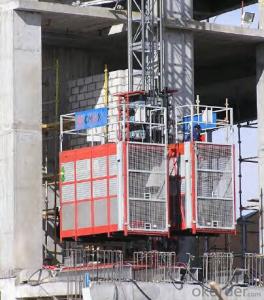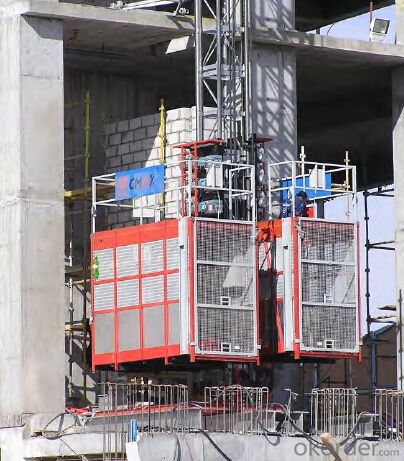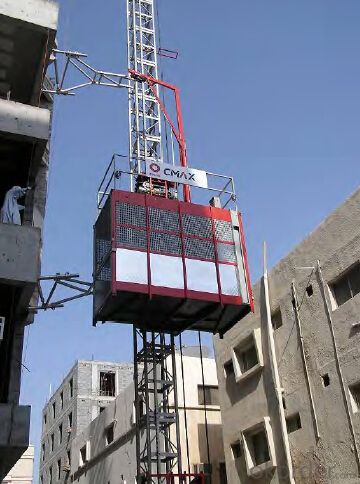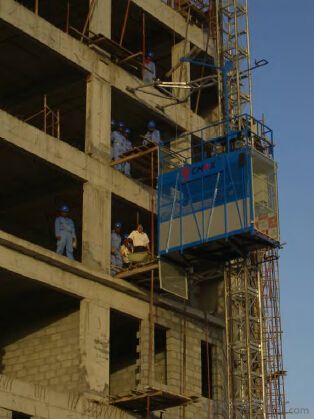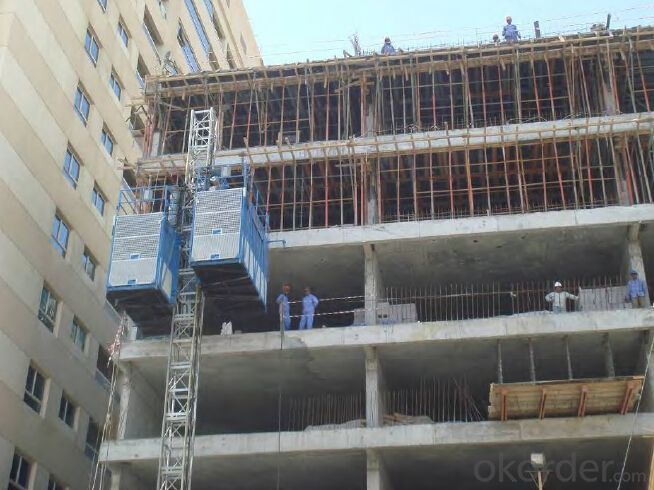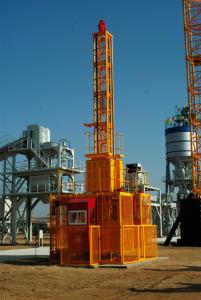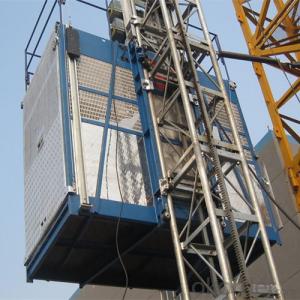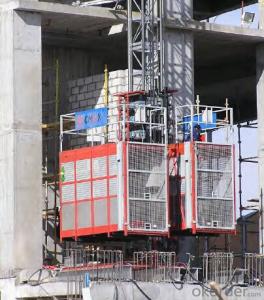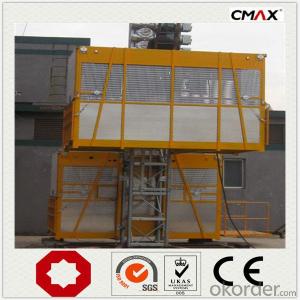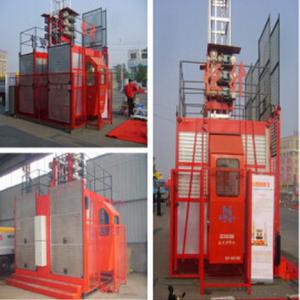Electric Building Construction Hoist Lift Elevator
- Loading Port:
- Tianjin
- Payment Terms:
- TT or LC
- Min Order Qty:
- 1 unit
- Supply Capability:
- 3000 unit/month
OKorder Service Pledge
OKorder Financial Service
You Might Also Like
SC200/200 3*2*11kw building electric hoist
Descriptions of our building hoist:
The general building hoist manufactured by our company have the features as good quality, long life, wide application range and convenient for maintenance, the gering adopts imported bearing, enameled cable, and oil seal, the electric parts adopt products from world renowned manufactures such as Schneider, Siemens, and LG, the racks and pinion adopts special material and heat-treatment technique, which prolong the life of these parts. The steel structure uses quality steel from famous domestic manufacturers, the surface of the structure can apply paint-spray, Parkerizing baking finish or hot galvanizing processing according to users requirements, the cage can be produced and decorated by aluminum molded board, punched-plate or figured aluminum board.
Main Features of Building Material Hoist
1. the recommended cage dimension(LXWXH):2.0X1.0X2.5, 2.5X1.0X2.5, 2.5X1.3X2.5, 3.0X1.5X2.5, 3.2X1.5X2.5, 3.8X1.5X2.5, 4.0X1.5X2.5, 4.2X1.5X2.5 etc, we can also manufacture cages of other size according to the user.
2. The cage and the door material can be aluminum molded board, punched-plate, figured aluminum board or other type according to your requirements.
3. The mast and the tie-in surface can adopt paint-spray, or hot galvanizeing processing.
Advantage of our building hoist:
1. Our own systems of production engineering.
2. Production design from the concept to the engineering details.
3. Technical experts with great experience in the sector.
4. Continuous development of new solutions and products adapted to the requirements of our clients.
5. Methodology and project procedure administration in compliance with current guidelines.
6. Extensive worldwide commercial network
Specification of our building hoist:
| Tye | Model | Lifting weight kg | Lifting speed m/min | Motor | Capacity | Mast section size (mm) | Cage size (mm) |
| General model | SC100/100Q | 1000*2 | 28 | 1 motor on cage top | 1*15kw | 650*650*1508 | 3200*1300*200 |
| SC150/150Q | 1500*2 | 28 | 1 motor on cage top | 1*15kw | 650*650*1508 | 2300*1400*2000 | |
| SC200/200A | 2000*2 | 36 | 2motors on cage top | 2*15kw | 650*650*1508 | 3200*1500*2500 | |
| SC200/200AV | 2000*2 | 0-70 | 2motors on cage top | 2*15kw | 650*650*1508 | 3200*1500*2500 | |
| SC200/200B | 2000*2 | 36 | 3 motors on cage top | 3*11kw | 650*650*1508 | 3200*1500*2500 | |
| SC200/200BV | 2000*2 | 0-70 | 3 motors on cage top |
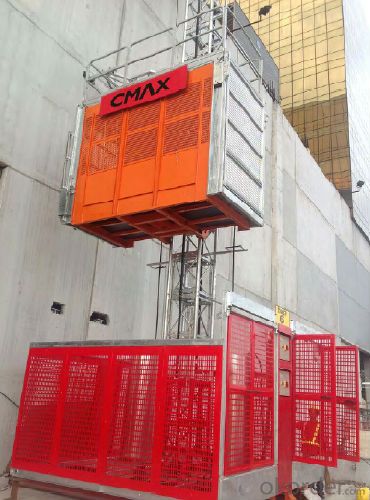
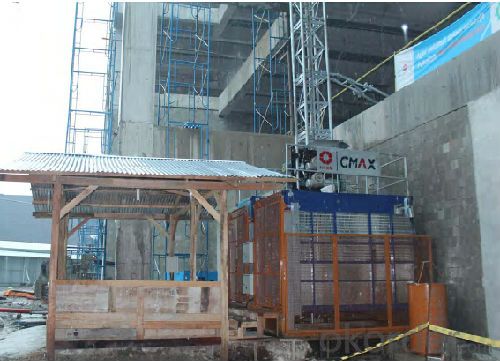


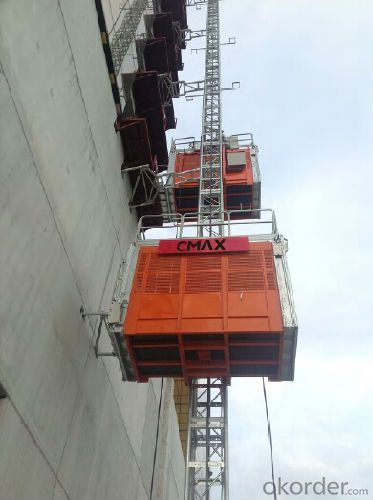
Production line
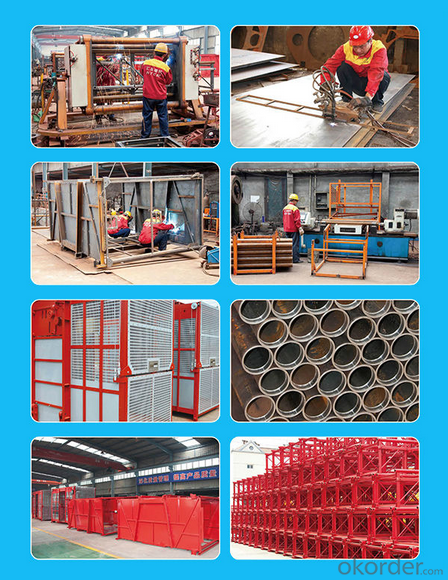
FAQ
1. why chose us?
China National Building Materials (Group) Corporation (CNBM), established in 1984,now is one of the largest state-owned group corporation in China, dealing with building materials & industrial equipment. Up to year 2010, CNBM Group's total asset is 20 billion USD and total staff is more than 100,000.CNBM International Corporation, specializes in designing & manufacturing of various
kinds of construction machinery, including tower crane, building hoist, etc. All the equipment produced by CNBM are compliant with the National level quality standard, and wins great reputation for their endurable performance in worldwide markets.
2.How about the shipment?
You can put 2 sets of of wheel loaders in one 40HQ container. The spare parts are packed with boxes.
The delivery time is 20 days.
3. What about your service?
We have our factory, we can meet customers needs as soon as possible.
We have first rate professional technology and provide good after-sales service.
4.After Sales Service
We offer the Preventative Maintenance and After Sales Service. For we strongly feels about the importance of supporting our customers and the product solutions we provide. Consequently we offer comprehensive maintenance options to prevent equipment issues before they become problems. Also we offer one year guarantee period.
- Q: This question asks for the methods used to maintain and care for a building hoist, which is a type of lifting equipment used in construction.
- <p>Regular maintenance of a building hoist is crucial for safety and efficiency. Key methods include daily inspections of cables, hooks, and safety devices for any signs of wear or damage. Lubricate moving parts as per the manufacturer's guidelines to reduce friction and prevent rust. Ensure that all electrical components are clean and dry, and check for any loose connections or damaged wires. Perform load tests periodically to confirm the hoist's lifting capacity and safety. Keep the control panel and all operational areas clean and free from debris. Regularly check the hoist's anchorage to ensure it is secure. Adhere to all manufacturer's recommendations for maintenance intervals and procedures. Proper maintenance can extend the life of the hoist and prevent accidents.</p>
- Q: What factors should be considered when selecting an appropriate building hoist for a specific construction project?
- <p>Choosing a suitable building hoist involves assessing several factors: the weight capacity required, the frequency of use, the height and number of floors in the building, the size and shape of materials to be lifted, and safety features. Consider the hoist's speed and efficiency, as well as its ease of installation and maintenance. Consult with hoist manufacturers or experts to ensure the hoist meets local safety regulations and fits the project's specific needs. Always prioritize safety, reliability, and compatibility with the construction workflow.</p>
- Q: Is it possible to operate building hoists in cold weather conditions?
- <p>Yes, building hoists can be used in cold climates, but they must be designed and maintained for such conditions. Cold weather can affect the performance of hoists, so it's crucial to use hoists specifically engineered for low-temperature operation. Regular maintenance and checks are necessary to ensure safety, as extreme cold can cause metal parts to contract and lubricants to thicken, affecting the hoist's functionality. Always follow the manufacturer's guidelines for operating hoists in cold climates.</p>
- Q: What steps are necessary to guarantee the safety and reliability of a building hoist?
- <p>To ensure a building hoist is safe and reliable for use, follow these steps: Conduct regular inspections and maintenance by qualified personnel. Check all mechanical and electrical components for wear and tear. Ensure all safety features, such as emergency stop buttons and limit switches, are functioning correctly. Verify that the hoist is properly secured to the building and that all load-bearing elements are capable of handling the weight. Adhere to the manufacturer's guidelines and specifications for operation. Train operators on the proper use of the hoist and emergency procedures. Regularly test the hoist's load capacity and stability. Keep records of all inspections, maintenance, and any incidents for future reference.</p>
- Q: This question asks for examples of typical uses for building hoists, which are devices used to lift materials in construction settings.
- <p>Building hoists are commonly used in various construction applications. They are utilized for lifting and lowering materials and personnel in high-rise construction projects. Some examples include: 1) Lifting building materials such as bricks, cement, and steel beams to different floors of a building under construction. 2) Transporting workers to elevated work areas for tasks like scaffolding assembly or window installation. 3) Moving heavy equipment to upper levels of a structure. 4) Assisting in the installation of large fixtures like HVAC systems or electrical wiring systems. 5) Facilitating the removal of construction waste from upper floors. These applications highlight the versatility and efficiency of building hoists in construction projects.</p>
- Q: This question asks about the typical issues encountered when constructing a building hoist and the methods to address these problems.
- <p>Common problems in building hoists include mechanical failure, safety hazards, and improper installation. Solutions involve regular maintenance to prevent mechanical issues, strict adherence to safety protocols to mitigate hazards, and professional installation to ensure the hoist is correctly set up. Additionally, using modern technology for monitoring and control can help to identify and rectify problems early. Ensuring proper training for operators is also crucial for the safe and efficient operation of building hoists.</p>
- Q: What types of materials can be transported using a building hoist?
- <p>A building hoist can lift a variety of materials, including construction supplies such as bricks, cement, sand, and gravel. It can also transport larger items like steel beams, prefabricated concrete elements, and heavy machinery. Additionally, it is used to move tools, equipment, and sometimes personnel within the construction site. The specific materials that can be lifted depend on the hoist's capacity and the safety regulations in place. It's crucial to ensure that the load does not exceed the hoist's weight limit to maintain safety standards.</p>
- Q: This question asks for guidelines on how to take care of lifting equipment after it has been used.
- <p>To maintain your lifting equipment after use, follow these steps: 1. Clean the equipment thoroughly to remove dirt, grease, and any debris. 2. Inspect all components for wear, damage, or signs of excessive use. 3. Lubricate moving parts as per the manufacturer's recommendations. 4. Check and tighten all bolts, nuts, and fasteners to ensure they are secure. 5. Store the equipment in a dry, clean, and well-ventilated area to prevent rust and corrosion. 6. Regularly review the manufacturer's maintenance schedule and perform any required servicing. 7. Keep a log of all maintenance and inspections to ensure you're staying on top of equipment care. Proper maintenance not only prolongs the life of your equipment but also ensures safety during use.</p>
- Q: How does the construction elevator add up
- You can use a ready-made high-altitude operating platform and a high-altitude working platform
- Q: What are the expenses involved in buying and maintaining a building hoist?
- <p>The costs of purchasing and operating a building hoist include the initial purchase price, which can range from $10,000 to $50,000 depending on the model and capacity. Operating costs involve maintenance, which may be around $1,000 to $5,000 per year, and electricity for operation, which can vary based on usage. Additionally, there may be costs for installation, insurance, and potential repairs. Labor costs for operating the hoist should also be considered, as well as costs for compliance with safety regulations. These costs can vary widely based on location, the specific hoist model, and the scale of operations.</p>
Send your message to us
Electric Building Construction Hoist Lift Elevator
- Loading Port:
- Tianjin
- Payment Terms:
- TT or LC
- Min Order Qty:
- 1 unit
- Supply Capability:
- 3000 unit/month
OKorder Service Pledge
OKorder Financial Service
Similar products
Hot products
Hot Searches
Related keywords
